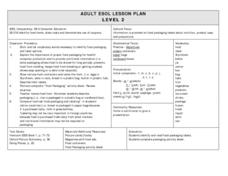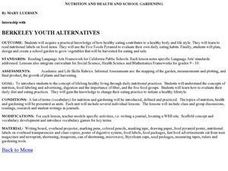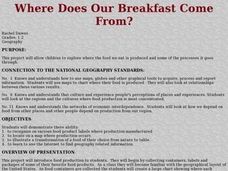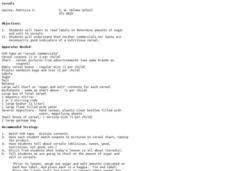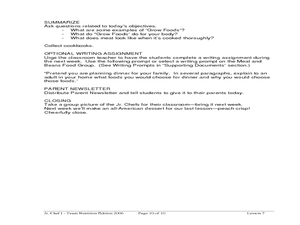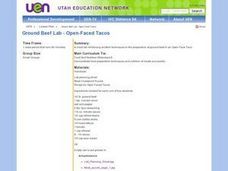Curated OER
Where Does Food Go?
Students understand how their food moves through the digestive system. In this digestion lesson, students measure the length of the digestive system from a projection of it. Students draw their own pictures of the digestive system.
Curated OER
How Does Your Garden Grow?
Young scholars read The Garden by Arnold Lobel, plant seeds to discover what makes them grow, and record their observations in their journals.
Curated OER
Where Do I Fit In The Food Pyramid?
Students discuss how their daily diets fit into the dietary guidelines set out by the food pyramid. They write a paragraph describing good health habits and identify areas where their personal diet can be improved.
Curated OER
Working Together to Solve a Problem
Students create a food and clothing drive at their school. In this philanthropy instructional activity, students listen to the story Selavi, That is Life, to help them understand homelessness. Then, students brainstorm ways to implement...
Curated OER
Introduction to Hours & Minutes
First graders identify, interpret, and gain proficiency in using a clock to tell time to the hour and determine how many minutes are in an hour. They identify and list what they do as they travel through their dayand how much time you...
Curated OER
ADULT ESOL LESSON PLAN--Level 2--Consumer Education
Students, after reviewing an extensive list of vocabulary terms on the board, identify/label food items, how much they cost and the value of using coupons to save money. In addition, they practice reading the labels on the food packaging...
Curated OER
Reading Labels For Fat Types
Students analyze a variety of cooking oils to determine the amount and types of fats included in each.
Curated OER
Nutrition and Health and School Gardening
Students examine how healthy eating contributes to a healthy body and life style. They read nutritional labels on food items. They use the Five Foods Pyramid to evaluate their own eating habits. They plan, design, and create a school...
Curated OER
What's Organic?
Students discuss background information presented by the teacher and read dictionary definitions for the words "organic" and "synthetic." In this gardengin instructional activity, students complete a worksheet on the material. Students...
Curated OER
Where Does Our Breakfast Come From?
Students bring in the cartons and containers of some of their favorite foods. They locate the origin of these foods on a map and visit a farm to view how food is grown and processed by a farmer. Students read books, complete worksheets...
Curated OER
Mmmmm, I'm Good! But Am I Good For You?
Learners explore the nutritional value of the potato, its role in the food pyramid, and how it can be a part of a balanced diet. For this potato nutrition lesson, students read about the nutritional value of potatoes. Learners work in...
Curated OER
Don't Worm Your Way Out of This One!
Students study different aspects of worms along with the process of vermicomposting by participating in a class experiment to study the time it takes for breakfast cereal to be eaten by worms.
Curated OER
Cereals
Young scholars watch television commercials, then analyze the nutritional value of the cereals. In this health and nutrition instructional activity, the teacher shows students several cereal commercials, then the young scholars describe...
Curated OER
Delicious Dinners by Jr. Chefs
Students create a protein-rich dinner. In this nutrition lesson, students brainstorm foods that are rich in protein. Students make burritos and identify the color of meat when it is cooked thoroughly.
Curated OER
The Numbers Tell the Story
Students demonstrate how to gather and interpret statistical data. In this data analysis lesson plan, students search for statistics on the health effects of smoking and place the information into charts. Students create these charts...
Curated OER
Nutrition
Fourth graders engage in an original unit about nutrition and record daily intake of food in order to help create a healthy eating plan. They practice making practical food choices for optimum health and then investigate how to maintain...
Perkins School for the Blind
Student Store
Vocational training activities are extremely important for learners with intellectual or physical disabilities. Here is a great idea that will help your class become skilled at money handling, basic economic concepts, interpersonal...
Curated OER
Movement concepts
Students recognize the connection between food labels and exercise. In this health lesson, students understand how many times they need to dribble to work off a snack. Students answer questions about the exercise.
Curated OER
Using Details from the Text
Explore non-fiction comprehension strategies with your class. They will visualize daily activities and label a 4 circle Venn diagram with related phrases. They must identify the overlapping sections as "main ideas," then complete a...
Curated OER
Open-Faced Tacos
Students practice safe handling procedures in a lab experience by handling ground beef properly in the preparation of a recipe. They prepare and assemble Open Faced Tacos. Afterward, they eat their prepared meal and complete several...
Creative Educator
Fantastic Fractions
Groups of learners create an animation illustrating fractions using common objects. They choose everyday objects that they can divide into fractions. They take pictures of the objects dividing into fractions and create an animation with...
Curated OER
Pedometer Calorie Counter Game
Students investigate food and calories. They examine the amount of work it takes to burn those excess calories.
Perkins School for the Blind
Grocery Shopping
Grab those reusable bags, it's time to go shopping! Intended to foster independent living skills in learners with visual impairments, the lesson covers several topics related to grocery shopping. They start by planning a meal, reading...
ARKive
Plants
Here is a one-hour activity that helps learners remember the parts of plants. Not only will the class learn about plant parts, they'll also discuss seed dispersal and plant growth. A celery experiment is used to show how plants obtain...





